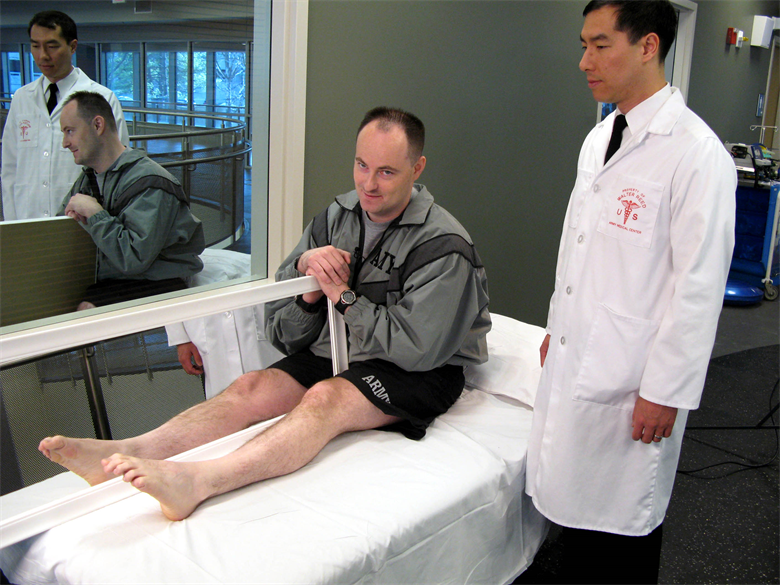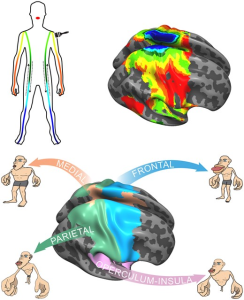Proprioception: Balance and Phantom Limbs
24 Phantom Limbs
Learning Objectives
Know what a phantom limb is.
Be able to describe three possible reasons that people experience phantom limbs or phantom pain.
Be able to describe how mirror boxes are used to treat phantom limb pain.
Know what congenital limb deficiency is.
Be able to explain why individuals with congenital limb deficiency experience phantom limb pain.
In this section, the focus of learning is to understand more about phantom limbs. Very few people have personal experience with phantom limbs because it requires for a limb to be absent. There are numerous causes of this ranging from car accidents where someone loses a limb to a birth defect where a child is born with only one arm or leg. Now, I think everyone is wondering, what is a phantom limb? A phantom limb is the sensation of feeling various things in a limb that is not there (e.g. a tingling sensation in an area where a limb no longer exists).
There are multiple complications that could be caused in experiencing sensations in limbs that are no longer existent. One of the main complications is phantom pain, which is a painful sensation in phantom limbs. There are three different ways that an individual could experience phantom pain. The first is called Neuroma, which is a physical source of pain caused by scarring on nerve endings. Sometimes, neuroma can be treated by surgery to remove the growth/tumor on the nerve, although the neuroma might re-grow after surgery, so the treatment is not always effective. The treatments for Cortical causes of phantom pain are less obvious. The first Cortical cause is negative sensory deprivation. For example, if the last thing a person felt on their arm before it got amputated was pain, the person’s brain could be stuck in that state. The second Cortical cause is sensory reorganization, and the issue here is that nerves from an amputated limb could grow back and infiltrate a different area of the body causing pain.

There is new technology being used, though, that can help people struggling from phantom pain with Cortical causes called mirror boxes. Mirror boxes are treatments that rewire the brain to portray a lack of sensory responses as not being painful. It allows a person’s brain to not think of an absence of sensory responses as pain and it allows the person to be at ease rather than feeling pain.
Moreover, you may be wondering how an individual could experience pain in a missing limb if they have never had one. Congenital limb deficiency is when an individual is born without a limb, failing to fully develop the limb in the uterus. There have been reports of these individuals having phantom pain in a limb they never had. The working theory for this is that the human body has a neural network that underlies the body schema (an organism’s internal model of it’s body and position of limbs) that develops regardless of whether or not it had received sensory input from a particular limb. Evidence exists that this neural network is developed due to genetic programming in the neonatal brain. Essentially an individual is born with a network in their brain that is innately aware of the body and it’s limbs; it is this neural network that allows for painful sensations to be received originating from the location the network knows the limb should reside in, regardless of whether or not the limb is actually there.

Exercises
- What is a phantom limb?
A. An arm or leg of a person
B. A person who had had a limb amputated
C. Limbs that are not present (due to amputation or congenital condition) but still perceived
D. A figment of the imagination - What is neuroma?
A. Inflammation or scar tissue on a nerve
B. Damage, disease, or dysfunction of one or more nerves especially of the peripheral nervous system that is typically marked by burning or shooting pain
C. The branch of medicine or biology that deals with the anatomy, functions, and organic disorders of nerves and the nervous system
D. Differing in mental or neurological function from what is considered typical or normal - How can neuroma be treated?
A. Prescribed medications
B. Do nothing
C. Tell your doctor
D. Surgery - What are the two cortical causes of phantom pain?
A. Pessimistic interpretation and mechanical sensation
B. Sensory reorganization and neuroma
C. Pessimistic interpretation of sensory deprivation and sensory reorganization
D. Phantom limbs and pain - What are mirror boxes?
A. A reflective surface, now typically of glass coated with a metal amalgamation that reflects an image
B. A neuron that fires when an animal acts and when the animal observes the same action performed by another
C. A condition that causes a person to feel the sensations of being touched on the opposite side of their body when they see another person being touched
D. Promising treatments that train the brain to interpret sensory responses, or the lack of sensory responses, as not painful
Answer Key:
- C
- A
- D
- C
- D
Cheryl Olman PSY 3031 Detailed Outline
Provided by: University of Minnesota
Download for free at http://vision.psych.umn.edu/users/caolman/courses/PSY3031/
License of original source: CC Attribution 4.0
Adapted by: Nathaniel Luers
Melzack R, Israel R, Lacroix R, Schultz G. Phantom limbs in people with congenital limb deficiency or amputation in early childhood. Brain. 1997 Sep;120 ( Pt 9):1603-20. doi: 10.1093/brain/120.9.1603. PMID: 9313643.

